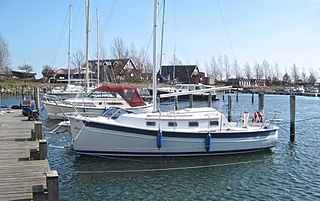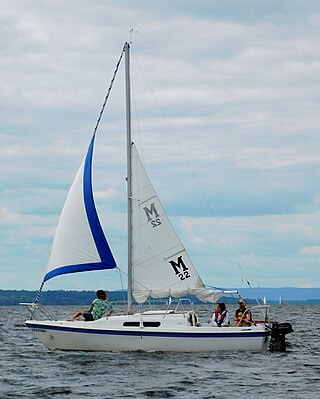Related Research Articles

The CS 22 is a Canadian trailerable sailboat, that was designed by John A. Butler and first built in 1971. The design is out of production.

The Seaward 22 is an American trailerable sailboat that was designed by Nick Hake and first built in 1985.

The Seaward 25 is an American trailerable sailboat that was designed by Nick Hake a cruiser and first built in 1984.
The Amphibi-Con 25, often just called the Amphibi-Con, is an American trailerable sailboat that was designed by E. Farnham Butler and Cyrus Hamlin as a racer-cruiser and first built in 1954. The design was one of the first "trailer sailers" and helped popularize this class of boat.
The Com-Pac 23 is an American trailerable sailboat that was designed by Clark Mills as a pocket cruiser and first built in 1978. The boat has undergone design changes over time resulting in a series of improved models.
The Ericson 23-1 is an American trailerable sailboat that was designed by Bruce King as a cruiser and first built in 1969.
The ETAP 23iL is a Belgian trailerable sailboat that was designed by Jacques de Ridder as a cruiser and first built in 1994.
The ETAP 26 is a Belgian trailerable sailboat that was designed by E. G. van de Stadt as a cruiser and first built in 1982.
The ETAP 26s is a Belgian trailerable sailboat that was designed by Marc-Oliver von Ahlen as a cruiser and first built in 2005.

The MacGregor 22 is an American trailerable sailboat that was designed by Roger MacGregor as a cruiser and first built in 1967.
The S2 6.9, also marketed as the S2 6.9 Grand Slam, is an American trailerable sailboat that was designed by Don Wennersten and Graham & Schlageter as racer-cruiser and first built in 1983. The designation indicates the approximate length overall in meters.
The Seaward 23 is an American trailerable sailboat that was designed by Nick Hake as a pocket cruiser and first built in 1984.
The Seaward 24 is an American trailerable sailboat that was designed by Nick Hake as a cruiser and first built in 1984.
The Seaward Fox is an American trailerable sailboat that was designed by Nick Hake as a pocket cruiser and first built in 1993.
The Slipper 17 is an American trailerable sailboat that was designed by Nick Hake as a pocket cruiser and first built in 1981.
The Seaward 26RK is an American trailerable sailboat that was designed by Nick Hake as a cruiser and first built in 2005.
The Seaward 32RK is an American sailboat that was designed by Nick Hake as a cruiser and first built in 2006.
The Seaward 46RK is an American sailboat that was designed by Nick Hake as a cruiser and first built in 2012.

The Sun Odyssey 440 is a French sailboat that was designed by Philippe Briand, Piaton Bonet Yacht Design and the Jeanneau Design Office as a cruiser and first built in 2017.
The Sun Odyssey 32 is a French sailboat that was designed by Philippe Briand as a cruiser and first built in 2002.
References
- 1 2 3 4 5 6 McArthur, Bruce (2021). "Seaward Eagle sailboat". sailboatdata.com. Archived from the original on 6 February 2022. Retrieved 6 February 2022.
- 1 2 3 4 5 6 7 Sea Time Tech, LLC (2021). "Seaward Eagle". sailboat.guide. Archived from the original on 6 February 2022. Retrieved 6 February 2022.
- 1 2 Perry, Robert H. (7 January 2002). "Seaward Eagle 32". Sailing Magazine. Archived from the original on 6 February 2022. Retrieved 6 February 2022.
- ↑ McArthur, Bruce (2022). "Hake Yachts (Seaward)". sailboatdata.com. Archived from the original on 13 September 2020. Retrieved 6 February 2022.
- ↑ Sea Time Tech, LLC (2022). "Hake Yachts (Seaward)". sailboat.guide. Archived from the original on 3 February 2022. Retrieved 6 February 2022.
- 1 2 Sail Staff (2 August 2017). "Seaward Eagle". Sail Magazine. Archived from the original on 6 February 2022. Retrieved 6 February 2022.